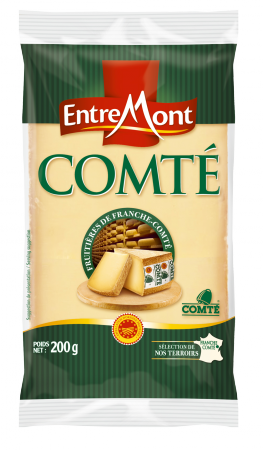How to taste cheeses

Cheese is about the taste but not just that! Eating cheese appeals to all of our senses ... we look at it, eat it, smell it, touch it, and more surprising, we listen to it. Entremont will guide you in preparing all of your senses to really appreciate all the subtleties of cheese.
Sight
This is the first sight that needs to be prepared when eating cheese. It whets the appetite and gets the mouth to water if the cheese looks good. It can sometimes offer valuable insights into the age of the cheese, the type of milk used to make it, or its origin. For example, two types of Reblochon cheese can be identified by their coloured casein. The red one presents a Reblochon made by a dairy while the green indicates a Reblochon farm cheese. This sense is therefore essential to get an idea of the cheese on our plate!
Smell
The flavour of food is inextricably linked to our sense of smell. All smells perceived by the nasal cavity form part of the taste and are called aromas. The taste and the smells associated are generally called "flavour".
There are several types of aroma when talking about cheese. An aroma can be tangy, musky, floral, toasted, herbaceous, lactic, fruity, roasted, vegetable, or spicy, like Epoisses which is said to have strong musky flavours. The smell of a cheese depends on its variety, how it was matured, and the region or terroir. If you want to smell a cheese properly, break a slice in half with your fingers to bring out all of the aromas.
It is during the first four or five mouthfuls that aromas are the most present. Try pinching your nose while eating your cheese. You will notice that you cannot identify its aromas. Smell is intimately linked to the brain's emotional centre (olfactory sensory memory). This is why the smell of a Raclette can send us back in time to a happy memory which will naturally put us in a good mood.
Touch
Finish off your cheese tasting by touching it! Texture, firmness, elasticity, roughness, softness, and temperature will give you valuable information to judge its quality and typicality. For example, an Emmental cheese will be rather supple while a Comté cheese will be hard.
Taste
The tastes perceived by our taste buds are categorised into four distinct groups: salt, sweet, sour, and bitter. Beaufort turns out to be a sweet tasting cheese, like other hard pressed cheeses. As taste is a multi-sensory impression, several senses are involved in eating. It is just as important as smell, sight, and touch and we need all of these senses to collect all the information needed to judge a cheese. Taste varies a lot from one person to another which is why we all like different cheeses!
Note
Most cheeses should ideally be eaten at room temperature so think to take them out of the fridge about half an hour before serving. Cheese tasting can be tried by everyone! Do not hesitate to initiate your children in the art!


Share